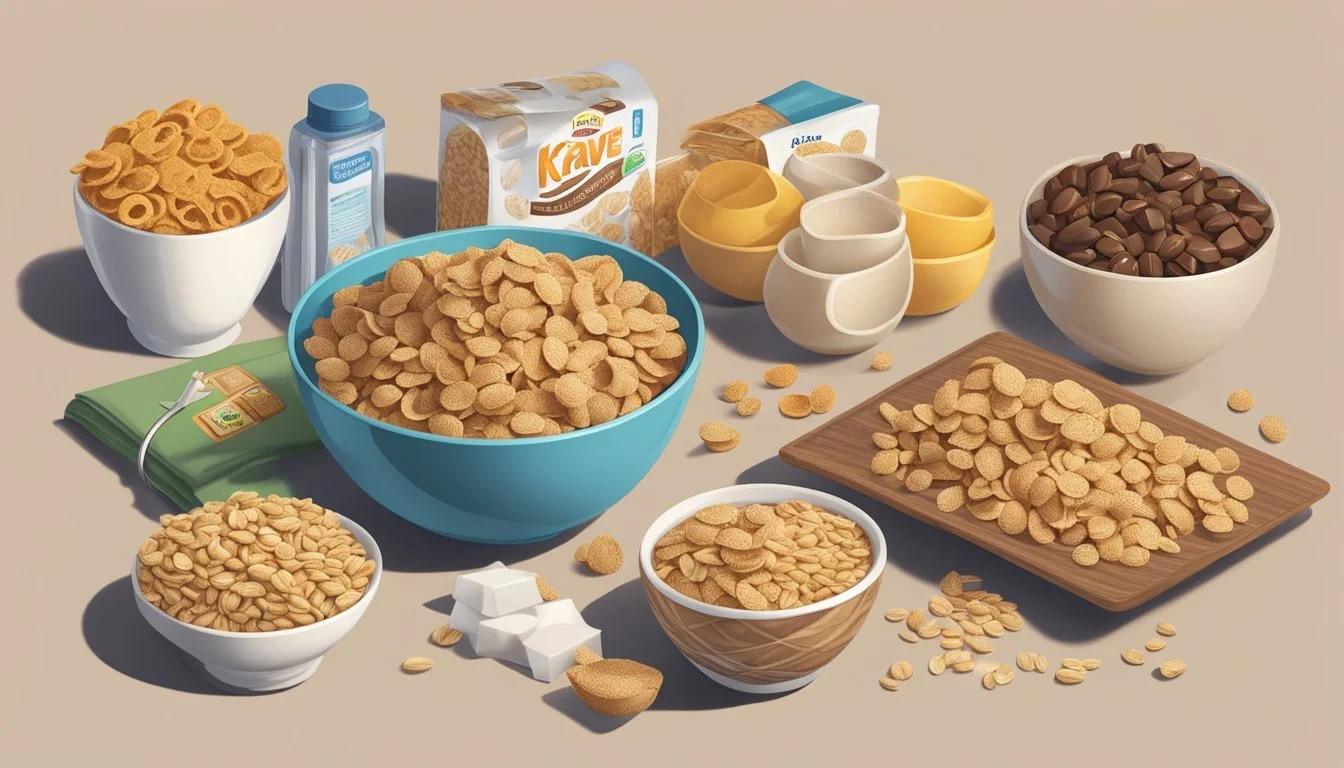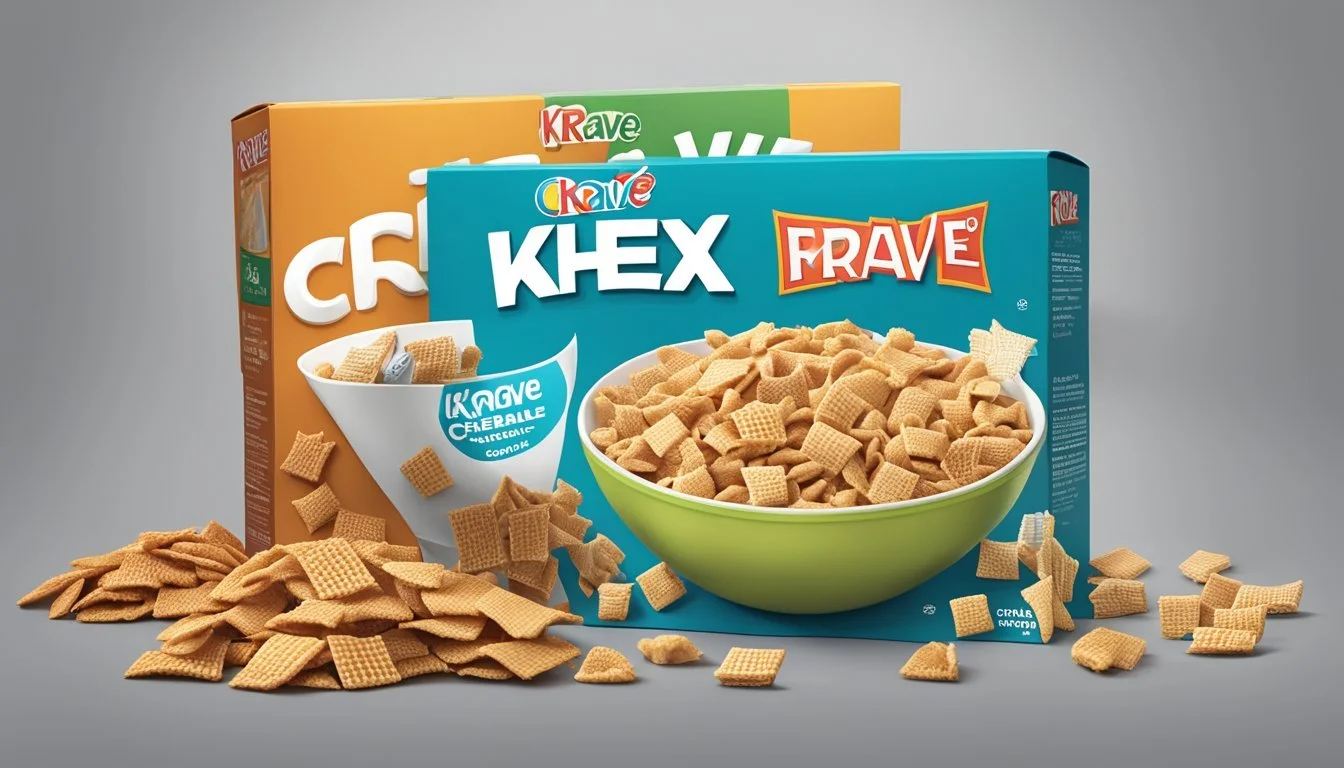Chex vs Krave
Comparing Two Popular Breakfast Cereals
This Article is Part of Our Breakfast Cereal Guide with Details on Chex Nutrition and Krave Nutrition
When choosing between Chex and Krave cereals, readers often find themselves at a crossroads of taste and nutritional value. Chex offers a savory flavor profile that is well-recognized from its popularity in Chex Party Mix, making it a versatile option not just for breakfast but also for snacks. It’s a familiar name in many households, known for its simple ingredients and ability to be adapted for various recipes.
In contrast, Krave brings a distinct chocolaty indulgence to the breakfast table. This cereal has garnered a following for its rich taste and delightful texture, reminiscent of beloved sweets like Milano cookies. Fans of Krave appreciate the luxuriously sweet flavor that adds excitement to their morning routine. For those who prioritize taste, Krave's delicious combination of cinnamony chocolate makes it a stand-out choice.
Determining whether Chex or Krave is the better option depends on individual preferences and dietary goals. While Chex might appeal to those seeking lower sugar content and a more traditional cereal experience, Krave caters to those with a sweet tooth looking for a treat-like start to their day. Each cereal has its unique strengths, making both worthy of consideration for any cereal enthusiast.
Nutritional Comparison
Chex and Krave are popular breakfast cereals but differ in their nutritional profiles, including caloric content, sugar levels, fiber and protein content, and the presence of vitamins and minerals.
Caloric Content
Chex Rice Chex contains about 100 calories per serving. Krave Chocolately Cereal has a higher caloric content, with 180 calories per serving.
These differences make Chex a lower-calorie option, suitable for those monitoring their caloric intake.
Cereal Calories per Serving Chex Rice Chex 100 Krave Chocolately 180
Sugar Levels
Chex Rice Chex contains 0 grams of sugar per serving, making it a virtually sugar-free option.
Krave Chocolately Cereal, on the other hand, has higher sugar content. Krave contains about 8 grams of sugar per serving, which includes added sugars. This notable difference makes Chex a preferable choice for those aiming to reduce their sugar intake.
Cereal Grams of Sugar per Serving Chex Rice Chex 0 Krave Chocolately 8
Fiber and Protein Content
Chex Rice Chex offers 1 gram of dietary fiber and 2 grams of protein per serving.
Krave Chocolately Cereal also provides 2 grams of dietary fiber and 3 grams of protein per serving. Although both cereals are relatively low in these nutrients, Krave slightly edges out Chex in terms of fiber and protein content.
Cereal Fiber per Serving Protein per Serving Chex Rice Chex 1 gram 2 grams Krave Chocolately 2 grams 3 grams
Vitamins and Minerals
Chex Rice Chex and Krave both contain essential vitamins and minerals, but the types and quantities vary.
Chex Rice Chex is fortified with vitamins and minerals, including iron and calcium. Krave Chocolately Cereal is similarly enriched with essential nutrients, but specific details on vitamins and minerals can vary by product batch. For example, Chex has 250 mg of sodium per serving, while Krave contains 150 mg of sodium per serving.
Cereal Notable Nutrients Chex Rice Chex Iron, Calcium, 250 mg Sodium Krave Chocolately Essential Vitamins, 150 mg Sodium
Ingredient Analysis
Chex and Krave cereals come with distinct ingredient profiles. While Chex focuses on whole grains and aims for simplicity, Krave caters to a more indulgent palate with its chocolate cereal composition.
Whole Grains and Gluten Content
Chex offers several varieties that typically include whole grains such as rice, corn, or wheat. Many Chex options are gluten-free, making them suitable for those with gluten sensitivities.
In contrast, Krave contains cereal flours that mainly consist of wheat, oat, and rice. These are not gluten-free. The inclusion of whole grains is present, but it forms part of a broader mix that includes refined grains.
Presence of Chocolate and Nuts
Krave is known for its chocolate filling. The main ingredient is sugar, with chocolate used to enhance the taste profile, making it a less healthy choice.
Chex does not contain any chocolate in its traditional flavors. Nut presence is also minimal, making it a better option for individuals with nut allergies. Chex instead utilizes natural flavors, spices, and some sweeter varieties might include ingredients like honey or cinnamon.
Additives and Flavorings
Krave incorporates several additives to maintain its flavor and structure, such as trisodium phosphate. It also includes artificial flavors to enhance taste, which can be a concern for health-conscious consumers.
Chex tends to rely on simpler ingredients. Additives in Chex are minimal, often including salt, brown sugar syrup, and other natural preservatives. This simplicity makes Chex a better option for those looking for fewer artificial ingredients.
Chex also avoids ingredients like soy and excessive sugars, present in other more indulgent cereals like Krave, which prioritizes taste over health.
Cereal Forms and Varieties
Chex and Krave offer distinct experiences that appeal to varying preferences. Their differences in texture, shape, and flavored varieties highlight what makes each cereal unique.
Texture and Shape
Chex cereals are characterized by their small, square lattice shapes, creating a crispy and crunchy texture. This shape is ideal for absorbing milk without losing integrity too quickly. Varieties like Corn Chex, Rice Chex, and Wheat Chex provide different textures based on their grain composition.
Krave, by contrast, features a pillow-like structure filled with a smooth chocolate center. This design delivers a combination of crunch and creamy texture in every bite. The exterior remains crisp, while the interior offers a decadent chocolate burst. This makes Krave a popular choice for those craving a richer cereal experience.
Flavored Varieties
Chex offers several flavored varieties, catering to both traditional and modern tastes. Popular flavors include Cinnamon Chex and Chocolate Chex. These provide a balanced taste, offering a low-fat, low-sugar option for those watching their intake. Chex's simplicity makes it suitable for recipes like Chex Mix.
Krave focuses heavily on rich, indulgent flavors. The primary variety is a blend of whole grain flours and a sweet chocolate filling. Other flavors include chocolate peanut butter mix and double chocolate. This aligns Krave with other sugary, dessert-like cereals such as Cocoa Pebbles and Cookie Crisp, fulfilling the craving for something more indulgent.
Both cereals offer a diverse range of textures and flavors, catering to a variety of preferences and breakfast desires. They provide options for those seeking either a wholesome or a treat-like cereal experience.
Health and Diet Considerations
Chex and Krave cereals vary significantly in their nutritional profiles, affecting their suitability for weight management, different age groups, and potential allergen risks.
Impact on Weight Management
Chex cereal can be a helpful choice for those seeking weight loss or management due to its lower sugar content and higher fiber levels. Higher fiber can improve satiety, making it easier to manage portion control and reduce overall calorie intake.
Krave cereal, on the other hand, has high sugar and lower fiber content, making it less ideal for weight management. The added sugars can lead to increased calorie consumption without providing sustained energy or fullness.
A diet emphasizing cereals with whole grains and fiber, such as Chex, can support weight management goals more effectively.
Suitability for Different Age Groups
Chex cereal is versatile for various age groups. It offers essential nutrients like fiber and can be incorporated into the diets of children, adults, and seniors. For children, Chex with milk provides a balanced breakfast. For adults and seniors, its fiber content supports digestive health.
Krave cereal, while appealing to children due to its sweet taste and chocolate filling, lacks sufficient fiber and has high sugar levels. This makes it less suitable as a healthy breakfast option for daily consumption, particularly for children and older adults concerned with nutrient-dense foods.
Both cereals can be enjoyed occasionally, but moderated intake is key, especially for younger and older consumers.
Allergen Information
Chex Mix often boasts a variety of flavors, some of which are gluten-free, catering to those with gluten sensitivities or celiac disease. Additionally, many Chex products are free from common allergens like nuts, making them a safer option for those with such allergies.
Krave cereal contains gluten and may not be suitable for individuals with gluten intolerance. Additionally, check for any milk derivatives if lactose intolerance is a concern.
Consumers must read labels carefully to identify potential allergens and choose options that fit their dietary restrictions, especially when dealing with gluten sensitivities or nut allergies.
Consumer Preferences
Understanding the preferences of consumers when it comes to breakfast cereals can provide valuable insights for brands. This section will cover the differing taste profiles and popular market trends that shape consumer choices for cereals like Chex and Krave.
Taste Profiles and Popular Flavors
Taste plays a crucial role in determining the popularity of cereals. Chex focuses on simpler, classic flavors such as honey, cinnamon, and chocolate. It is known for its light, crispy texture and adaptability in various recipes. Varieties like Cinnamon Chex and Chocolate Chex frequently attract those looking for a delightful morning meal without overwhelming sweetness.
On the other hand, Krave is famous for its bold, chocolate-filled crunch. It appeals to those with a penchant for indulgent, dessert-like cereals. Flavors such as Double Chocolate and S’Mores tend to be favorites among chocolate enthusiasts. In rankings of chocolate cereals, Krave often competes with other heavyweights like Cocoa Puffs and Chocolate Cheerios.
Market Trends and Popular Brands
Consumer preferences in the cereal market often shift, but several trends stand out. Recently, there has been a notable inclination towards cereals that offer health benefits and unique flavors. Brands such as Kellogg's Krave and General Mills' Chex have adapted by introducing diverse flavors and healthier options.
Chex continues to be popular among those who seek gluten-free options and versatile use beyond just breakfast, often appearing in snack mixes. Meanwhile, Krave resonates with the growing trend of snack-like cereals, providing a sweeter alternative to morning meals.
Other trendy cereals include nostalgic varieties like Cinnamon Toast Crunch and Honey Bunches of Oats, which consistently score high in taste tests. These market trends highlight the dynamic nature of consumer preferences and the importance of flavor innovation in maintaining brand loyalty.
Branding and Packaging
Chex and Krave cereals feature distinct approaches in their branding and packaging. Each brand uses unique visual elements, targeted marketing strategies, and varied box sizes to appeal to their specific audiences.
Visual and Marketing Elements
Chex presents a classic, straightforward design. It often highlights its association with General Mills, with a focus on simplicity and versatility, suggesting that Chex can be used in different recipes. The packaging prominently displays the cereal's benefits, such as being gluten-free.
Krave, produced by Kellogg’s, opts for a bold and fun aesthetic. The packaging is colorful and playful, reflecting its appeal to a younger audience. It focuses on indulgent flavors, showcasing chunks of chocolate to emphasize the cereal's sweet taste.
Both brands incorporate familiar elements. Chex maintains a clean design with a prominent logo, while Krave uses dynamic graphics and appealing imagery to stand out.
Box Sizes and Convenience
Chex offers a variety of box sizes, from small snack portions to larger family packs. This variety caters to different consumer needs, whether it’s a quick snack or a staple for family breakfasts. Smaller packs add convenience for on-the-go consumption.
Krave also provides multiple box sizes. The primary focus lies on medium to large-sized boxes, which are ideal for families or frequent users. These sizes emphasize value and bulk usage, reflecting Kellogg's strategy to position Krave as a staple breakfast option.
Both brands ensure their cereals are readily available in major retailers, enhancing convenience for consumers seeking either a quick snack or a bulk purchase.








